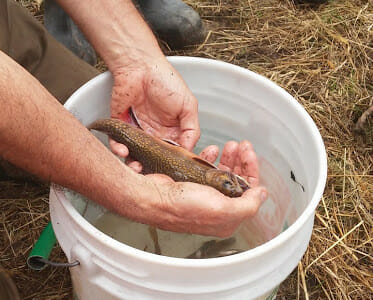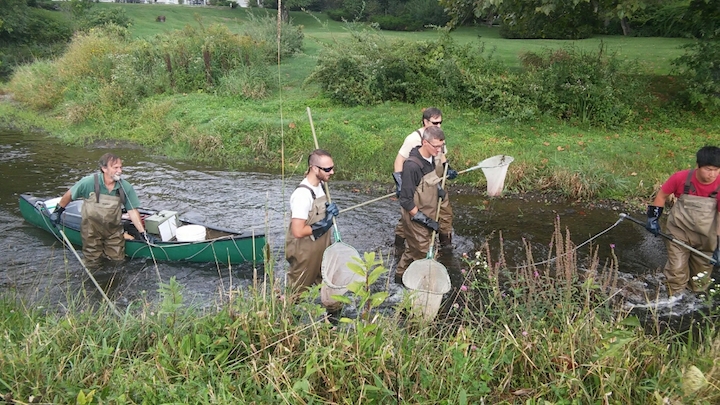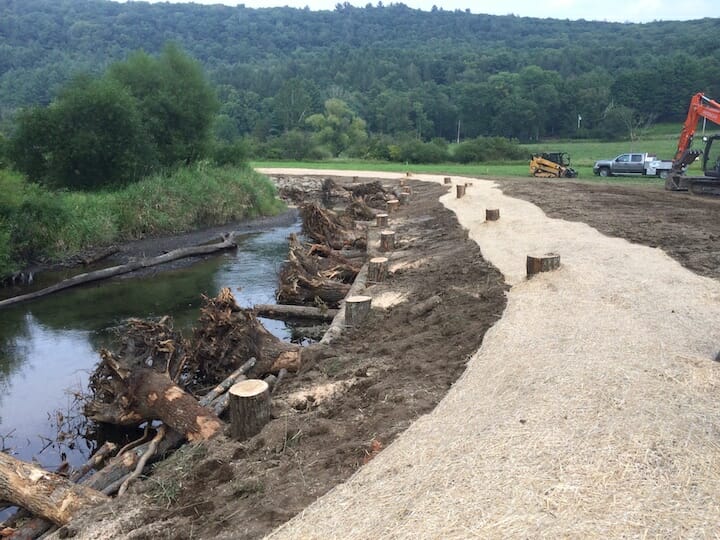Restoration construction efforts on this section of the Salmon Kill were almost complete when this picture was taken.
Trout stream restoration projects can make a big immediate visual impact, but the real payoff comes over time.
Still, it was a nice surprise when crews doing some stream sampling work at a restoration site on Connecticut’s Salmon Kill stream near Salisbury found two brook trout this summer — just as the first phase of the project was getting rolling. Sampling at the site hadn’t turned up any trout in the area in the previous three years.Mike holding brook trout[4].jpg

The finding of brook trout during sampling of the Salmon Kill bodes well for the long-term impact of the extensive restoration project now under way.
The Salmon Kill project is designed to restore and enhance the riparian habitat and instream habitat of a creek that’s an important tributary to the famous Housatonic River. The Salmon Kill is known to have brook trout in the upper watershed, while the lower section is brown trout water.
Very little riparian habitat remains along portions of Salmon Kill Creek — sometimes locally referred to as Salmon Creek — and bare and eroding stream banks have resulted in elevated water temperatures that limit suitable trout habitat.
The stream’s potential is enhanced by marble and limestone substrate that result in high alkalinity and good productivity. Improving trout habitat in the stream will have a positive impact on the trout population in the “Housy,” one of the most popular trout rivers in Connecticut. The Salmon Kill flows into the Housatonic just above the larger river’s Wild Trout Management Area.
Planning for the project began in 2012, and the first significant work got under way this summer. Work will continue through 2018.
This is a collaborative project among the US Fish and Wildlife Service, private landowners and Trout Unlimited.DEEP sampling site 1 and 2 2015[3].jpg

Sampling crews work through a section of the Salmon Kill. Their efforts turned up two brook trout in an area where no brookies had been found during sampling the three prior years.
TU is coordinating the restoration activities with local agencies and organizations, including the Salisbury Association Land Trust, Weantinogue Land Trust, the Connecticut Department of Energy and Environmental Department and the Housatonic Valley Association.
Local schools also have been involved, with students from Housatonic Valley Regional High School and Hotchkiss among those helping with riparian plantings and stream sampling efforts.
George Fowler of Woidt Engineering is the project’s designer and engineer, and former TU staffer Jim MacCartney also helped with the project design.
Riverlogic Solutions Inc. did the installation of the instream log revetments, using wood harvested locally and provided by Gary O’Cain of Clover Mountain Farm.
Farmers Allen and Robin Cockerline helped throughout the process, working around the team as they completed their daily tasks and keeping curious cattle elsewhere during construction.
The project has been funded as part of the Natural Resource Damages assessed to General Electric for the release of PCBs into to the Housatonic River Basin. It is part of the Housatonic River Basin Natural Resources Restoration Project as determined and administered by the Natural Resources Trustee SubCouncil for Connecticut.
With sampling teams already finding brook trout in the restoration area, hopes are high that trout numbers will continue to increase as the work continues and begins to pay its long-term dividends.



